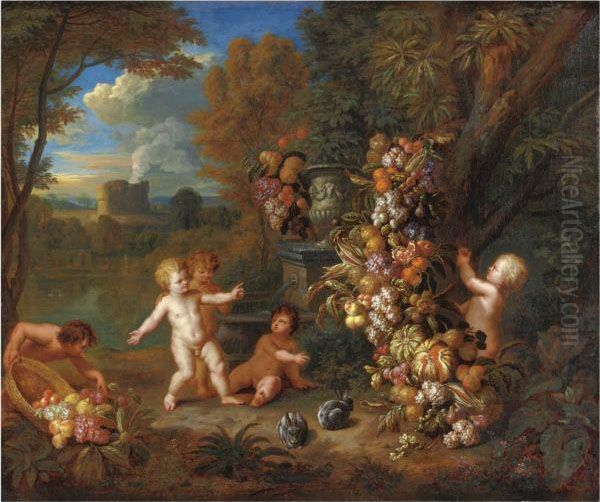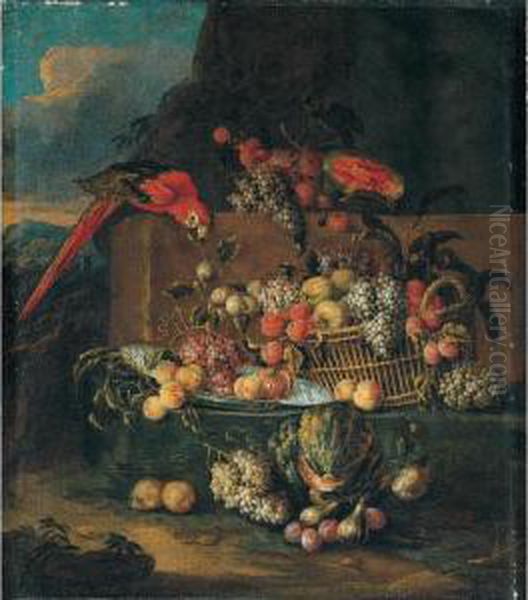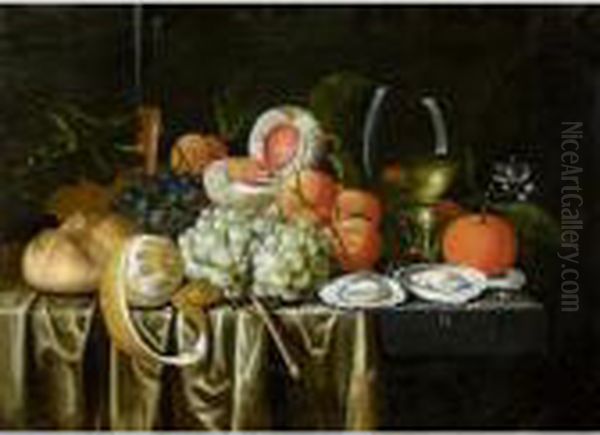Jan Pauwel Gillemans the Younger, a prominent figure in the Flemish Baroque tradition, carved a significant niche for himself as a painter of exquisite still lifes. Active primarily in Antwerp during the latter half of the 17th century, his work is characterized by a meticulous attention to detail, a rich palette, and a sophisticated understanding of composition and light. Emerging from an artistic family, Gillemans the Younger built upon a strong foundation, developing a style that, while rooted in the established conventions of Flemish still life, also bore his unique sensibility. His legacy endures through his vibrant depictions of fruit, flowers, and occasionally, symbolic arrangements that invite deeper contemplation.
Artistic Lineage and Early Influences
Born in Antwerp around 1651, Jan Pauwel Gillemans the Younger was destined for a life in the arts. His father, Jan Pauwel Gillemans the Elder (c. 1618–1675), was himself a respected still life painter, known for his fruit and flower pieces. This familial connection undoubtedly provided the younger Gillemans with his earliest exposure to the techniques and thematic concerns of still life painting. Growing up in an environment where artistic creation was a daily practice would have been immensely formative. The elder Gillemans' workshop would have been a schoolroom, where observation and imitation laid the groundwork for his son's future career. The family's background, with his paternal grandfather being a goldsmith, also suggests an appreciation for fine craftsmanship and detailed work, qualities evident in the paintings of both father and son.

Beyond his father's immediate influence, Jan Pauwel Gillemans the Younger formally apprenticed with Joris van Son (1623–1667). Van Son was a highly regarded still life specialist in Antwerp, celebrated for his opulent fruit arrangements, often set against dramatic, shadowy backgrounds. Van Son's tutelage would have been crucial in refining Gillemans' technical skills and shaping his artistic vision. The master-apprentice relationship in 17th-century Antwerp was rigorous, involving years of dedicated study, from grinding pigments and preparing panels to eventually collaborating on paintings. It is interesting to note a familial connection here as well: Gillemans the Younger's mother, Cornelia van Heulens, was reportedly the eldest daughter of Joris van Son, making his master also his maternal grandfather by marriage, further intertwining their artistic and personal lives.
The Antwerp Art Scene and Guild Membership
Antwerp in the 17th century, despite the economic and political shifts following the Dutch Revolt, remained a vibrant center for the arts. The city boasted a rich artistic heritage, home to giants like Peter Paul Rubens and Anthony van Dyck earlier in the century, and continued to support a thriving community of painters specializing in various genres. Still life painting, in particular, flourished, catering to the tastes of a prosperous bourgeoisie eager to adorn their homes with depictions of nature's bounty and symbols of wealth and transience.
A pivotal step in any Antwerp artist's career was admission into the Guild of Saint Luke. This venerable institution regulated the art trade, set standards for craftsmanship, and provided a framework for training and professional practice. Jan Pauwel Gillemans the Younger is recorded as becoming a master in the Antwerp Guild of Saint Luke in the guild year 1673–1674. This official recognition signified his competence as an independent artist, allowing him to establish his own workshop, take on apprentices, and sell his works freely. Membership in the guild placed him among esteemed contemporaries and predecessors who specialized in still life, such as Frans Snyders, Osias Beert the Elder, Adriaen van Utrecht, and Jan Fyt, all of whom contributed to Antwerp's reputation as a powerhouse of still life painting.
The artistic environment of Antwerp was competitive yet collaborative. Artists often specialized, and collaborations were not uncommon, particularly between figure painters and still life or landscape specialists. While direct collaborations involving Gillemans the Younger are not extensively documented in the same way as, for example, Rubens with Snyders or Jan Brueghel the Elder, the shared artistic milieu meant a constant exchange of ideas and stylistic influences. He would have been aware of the works of other prominent still life painters active during his time, including those working in slightly different but related subgenres, like the flower painter Daniel Seghers or the more austere compositions of Clara Peeters from an earlier generation.
Artistic Style and Thematic Concerns

Jan Pauwel Gillemans the Younger's oeuvre primarily consists of still lifes featuring abundant arrangements of fruits, often complemented by flowers, vegetables, and occasionally small animals or insects. His style is deeply rooted in the Flemish Baroque tradition, characterized by a high degree of realism, rich colors, and a tactile rendering of textures. He demonstrated a keen ability to capture the sheen of a grape, the fuzz of a peach, or the delicate translucency of a currant.
A significant influence on his style, beyond his father and Joris van Son, was the work of Jan Davidsz. de Heem (1606–1684). De Heem, though Dutch by birth, worked in Antwerp for a considerable period and was a towering figure in the development of the pronkstilleven, or ostentatious still life. Gillemans the Younger adopted elements of de Heem's approach, particularly the lavish compositions, the sophisticated interplay of light and shadow to create depth and volume, and the use of a warm, often golden, light that bathes the scene. His arrangements are typically generous, with fruits spilling from baskets or arranged on stone ledges, sometimes in outdoor settings.
While many still lifes of the period were imbued with symbolic meaning, often alluding to vanitas (the transience of life and earthly pleasures) or the bounty of creation, Gillemans' works, like many of his contemporaries, could be appreciated on multiple levels. The sheer beauty and verisimilitude of the depicted objects offered aesthetic delight. However, elements like insects, wilting flowers, or overripe fruit could subtly remind the viewer of the fleeting nature of beauty and life. The choice of exotic fruits or valuable tableware, when present, could also signify wealth and status, or conversely, serve as a warning against excessive materialism.
His compositions are often dynamic, with diagonal arrangements and a sense of movement, yet they maintain an overall harmony and balance. The interplay of textures – the smooth skin of an apple against the rough rind of a melon, the delicate petals of a flower beside a hard stone surface – is a hallmark of his skill. He paid close attention to the effects of light, using it to highlight certain elements and cast others into soft shadow, thereby enhancing the three-dimensionality of the scene.
Notable Works and Their Characteristics
Several works by Jan Pauwel Gillemans the Younger exemplify his artistic prowess and typical subject matter. While a comprehensive catalogue raisonné might be elusive, attributed paintings in various collections and auction records provide insight into his output.

One such example is often titled along the lines of "Still Life of Fruit and Vegetables in a Park Landscape with a Macaw and Two Guineapigs." This type of composition showcases his ability to integrate still life elements into a broader, albeit often idealized, landscape setting. The inclusion of live animals, such as a colorful macaw or small guinea pigs, adds a lively touch and demonstrates his versatility. The fruits and vegetables are rendered with his characteristic precision and vibrant color, while the park-like background, perhaps with classical architectural elements, lends an air of sophistication. Such paintings reflect a trend in later Baroque still life where the arrangements become more elaborate and are sometimes situated in more complex environments.
Another characteristic type of work is the "Trionfo di frutta con Putti" (Triumph of Fruit with Putti). These compositions often feature cherubic figures, or putti, interacting with lavish displays of fruit, sometimes in the form of garlands or overflowing baskets. The putti, derived from classical and Renaissance art, add a mythological or allegorical dimension to the still life. These works highlight Gillemans' skill in figure painting, albeit on a small scale, and his ability to create a sense of joyful abundance. The combination of meticulously painted fruit with the playful presence of putti creates a decorative and celebratory effect.
The "Allegory of the Earth - Landscape with Ceres, Putti, and Rich Fruit Trees" points to a more explicitly allegorical intent. Ceres, the Roman goddess of agriculture and harvests, would naturally be surrounded by the earth's bounty. Such paintings move beyond simple depiction into the realm of allegory, celebrating fertility and abundance. The inclusion of rich fruit trees and putti further enhances this theme. This demonstrates Gillemans' engagement with classical mythology, a common intellectual currency among educated patrons and artists of the period.
Similarly, a work titled "Putti with a Festoon of Fruit (and Guineapigs)" again combines the playful element of putti with a decorative festoon or garland of fruit. Garlands were a popular motif in Flemish still life, often associated with artists like Jan Brueghel the Elder or Daniel Seghers, who sometimes collaborated with figure painters like Rubens to create "cartouche" paintings where a central religious or mythological scene was framed by a meticulously painted floral or fruit garland. Gillemans' take on this theme, incorporating putti and animals, aligns with the decorative and opulent tastes of his patrons.
An "Allegory of Earthly Love" is also mentioned in connection with his name, suggesting that he ventured into more complex allegorical subjects where still life elements would play a crucial symbolic role in conveying the painting's message. The specific iconography of such a piece would involve carefully chosen objects to represent themes associated with love, desire, and perhaps their fleeting nature.
These examples illustrate the range within Gillemans the Younger's specialization. While fruit remained a central focus, its presentation varied from straightforward arrangements to more complex compositions integrated with figures, animals, and landscape elements, often carrying allegorical or symbolic weight. His ability to render textures, capture the play of light, and create harmonious compositions solidified his reputation.
Collaborations, Contemporaries, and Wider Artistic Context
While Jan Pauwel Gillemans the Younger was primarily known for his independent still life works, the artistic environment of 17th-century Antwerp fostered a degree of interaction among artists. He was a contemporary of Frans van Everbroeck (c. 1638–c. 1676), who was also a student of Joris van Son. It is plausible that they knew each other and perhaps even shared insights or friendly rivalry, common in guild circles. The influence of Joris van Son on both artists is a clear connecting thread.
The broader context of Flemish still life painting during Gillemans' active years included artists who continued to explore and refine the genre. While the towering figures of the early to mid-17th century like Frans Snyders, known for his monumental market scenes and game pieces, or Adriaen van Utrecht, with his elaborate banquet scenes, had set high standards, the later generation, including Gillemans, adapted these traditions. There was perhaps a move towards slightly more elegant and less overtly robust compositions in some quarters, possibly reflecting evolving tastes and even influences from French art, which was gaining prominence. The mention of "French Classicism" in some descriptions of his style might allude to a greater sense of order and clarity in his arrangements compared to the more tumultuous dynamism of some earlier Baroque works.
Other notable still life painters active in the Low Countries during this broader period, whose works Gillemans might have known, include Dutch masters such as Willem Kalf, renowned for his sumptuous pronkstilleven with reflective silverware and Chinese porcelain, or Pieter Claesz. and Willem Claesz. Heda, masters of the more subdued "monochrome banketje." While their styles differed, the cross-pollination of ideas between the Northern and Southern Netherlands was ongoing, despite political divisions. Artists travelled, and paintings circulated, ensuring a dynamic exchange of artistic innovations.
The demand for still life paintings remained strong throughout Gillemans' career. Patrons included wealthy merchants, nobles, and even fellow artists. The fact that his works were collected by figures such as Wolfert van Wolfswinkel and Geraert van Dorth, as indicated in some records, attests to his contemporary appeal and the esteem in which his art was held. Such patronage was vital for an artist's livelihood and reputation.
Later Life and Enduring Legacy
Jan Pauwel Gillemans the Younger continued to work in Antwerp, contributing to the city's artistic output until his death, which is recorded as being in Antwerp in 1704. He married Paulina Uyt de Eeckhout and is said to have had a large family, with several children. Whether any of his children followed directly in his artistic footsteps is not as clearly documented as his own apprenticeship under his father and Joris van Son.
His legacy lies in his contribution to the rich tapestry of Flemish Baroque still life painting. His works are appreciated for their technical skill, their vibrant depiction of natural abundance, and their embodiment of the aesthetic values of his time. While he may not have achieved the same level of international fame as a Rubens or a Van Dyck, or even the very top tier of still life specialists like Jan Davidsz. de Heem, Gillemans the Younger was a highly proficient and respected master within his chosen genre.
His paintings can be found in various museum collections and private hands, allowing contemporary audiences to appreciate his artistry. They serve as valuable examples of the quality and diversity of still life production in 17th-century Antwerp. Art historians and connoisseurs continue to study his work to understand the nuances of his style, his place within the Gillemans family of artists, and his relationship to his contemporaries.
Conclusion: A Master of Detail and Abundance
Jan Pauwel Gillemans the Younger stands as a significant exponent of Flemish still life painting in the latter part of the 17th century. Nurtured in an artistic family and trained by a leading master, he absorbed the rich traditions of Antwerp painting while developing his own refined style. His works, characterized by meticulous detail, luscious color, and harmonious compositions, celebrate the beauty and bounty of nature, often with subtle allegorical undertones.
From opulent arrangements of fruit and flowers to more complex scenes incorporating figures and animals, Gillemans demonstrated a consistent level of skill and artistry. His membership in the Guild of Saint Luke and the patronage he received underscore his contemporary success. Today, his paintings offer a window into the aesthetic preferences and cultural values of his era, securing his place as a noteworthy contributor to the enduring legacy of Flemish Baroque art. His dedication to the still life genre ensured that the tradition of detailed, vibrant, and often symbolic depictions of the natural world continued to thrive in Antwerp.